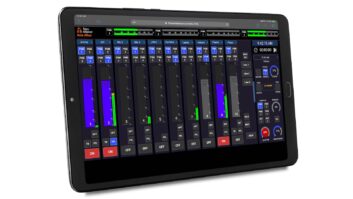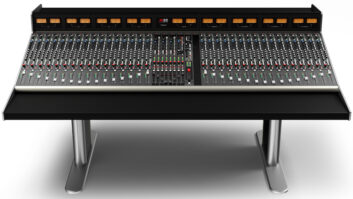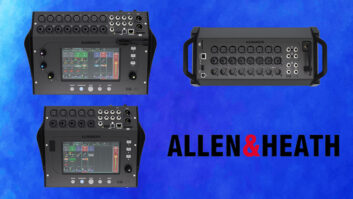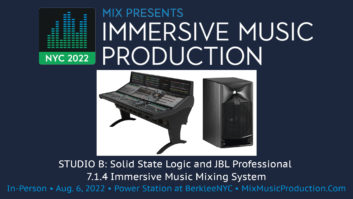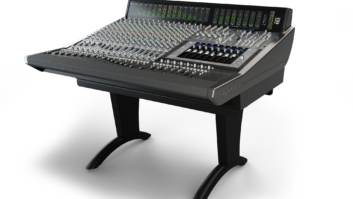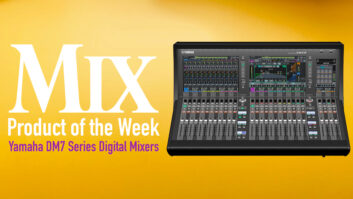There are more than a dozen entries in the “low cost” (i.e., less than $10,000) category of digital consoles, but in terms of pricing, performance and fast, logical interface, the Digital 328 from Spirit by Soundcraft clearly sets itself apart from the pack. For example, the 328 ships complete, ready to go right out of the box: So whether you need analog or digital I/O, the board is equipped to handle either, and it includes 16 channels of ADAT Lightpipe and Tascam TDIF interfacing as standard, along with 16 analog line/mic inputs. And unlike some of its competition, the 328’s list price of $4,995 is for a functional mixer, rather than the old “Here’s your new car-but by the way, did you want tires with that?” routine.
That said, the 328 does offer some useful options, including a cascade cable for linking two mixers; 8-channel mic-preamp-to-TDIF module (add two to give the 328 32 mic inputs, say for live sound/ theater use); TDIF to eight-channels of AES/EBU sends/returns; and an analog tape interface providing eight additional tape sends/returns.
Physically, the mixer takes up a small 21×28-inch footprint and weighs in at just over 31 pounds. But under the hood, the 328 packs a substantial punch, with 100mm moving faders; 42 inputs on mixdown; dynamic (SMPTE/MIDI driven) or 100-scene snapshot recall of nearly every console control; two onboard Lexicon multi-effects; Orban-designed dynamics; digital and analog effects sends to external processing; RS-422 port for loading software upgrades via a PC or Sony 9-pin control; word clock I/O; MIDI in/out/thru; MMC controls with both transport keys and the ability to arm up to 16 tracks; and main outs in both digital (S/PDIF and AES/EBU) and analog (balanced XLR and unbalanced RCA) formats. An additional Lightpipe output is assignable to the aux bus, FX bus, mix output or group buses. This is useful for connecting Lightpipe-equipped digital effects, such as the Alesis Q20, directly to the 328’s sends, staying completely in the digital domain.
Careful attention was paid to the 328’s audio pathways throughout. The 328 uses Soundcraft’s UltraMic+[superscript]TM padless preamps, 24-bit ADCs and DACs and 56-bit internal processing, and here the 328 really shines: These low-noise mic preamps are clear and transparent with tons of headroom.
The two onboard Lexicon units feature reverb, delay, chorus, flange, etc. and multi-patches, such as chorus plus delay. The 328’s two mono or stereo dynamic processors offer compression, limiting or gating, and are assignable to any input, output or I/O group.
Also on the input side, each of the analog 16 channels uses standard balanced XLRs for mics and TRS 11/44-inch balanced line connections-there’s none of that “six XLRs for mics followed by ten TRS mic input jacks” approach here. A global switch supplies 48 VDC phantom power to the mic inputs.
USER INTERFACE
The master section is based around a parameter/data wheel, four cursor arrow keys, enter/undo/redo/ exit buttons, 2-line by 16-character backlit LED screen and switches for entering the snapshot, dynamics/effects or main setup menus. Data entry is fast, and it’s nice to have a large lighted Undo or Exit key in those rare moments when you’re starting out on the board and momentarily get lost. Speaking of lighted keys, every switch on the 328 (except for the high-pass input filters) is either lighted or has an LED next to it to indicate status. A snapshot section offers quick access to 100 snapshots for storage/ recall/editing, with the ability to name each snapshot. Every desk parameter except channel gain and HPF filter settings can be stored, and snapshots can be triggered/recalled manually, or via MIDI clock, MTC or SMPTE. Dynamic automation allows for MIDI control of console parameters/settings such as level, pan, EQ, reverb and aux level from a MIDI sequencer.
Two 15-segment main meters monitor output levels and dynamics activity, while 16 meters (10-segment LEDs) in the channel section can be instantly switched in banks to display levels of mic/line inputs, tape return signals, and group and master levels. With this kind of flexibility, there’s no need for an external meter bridge-another “option” you won’t need to buy.
IN USE
The manual is straightforward and generally complete, but as with most digital devices, the documentation bypasses essential touches such as schematics, flow charts or block diagrams, although operations are explained in detail, including hookup illustrations. However, due to the 328’s logical user interface, you probably won’t really need the manual, except for some advanced functions. Spirit has thoughtfully provided a useful QuickStart Guide for smooth interconnecting with various Tascam or ADAT MDMs, where minor quirks in different operating software versions of these MDMs (even with the same model number) have caused clocking problems with digital consoles.
In operation, the 328 is fast and intuitive, thanks in large part to its E-Strip interface. Laid out horizontally across the top of the fader section, the E-Strip is a row of rotary encoders and backlit buttons that simply contains all the controls found on a traditional analog console (EQ, aux and panpots), but turned sideways. So if you want to tweak the EQ on channel 13, merely push the select key above channel 13’s fader and start tweaking the EQ knobs immediately. A bank switch determines whether the E-Strip (and moving faders) correspond to channels 1 to 16 or 17 to 32; touch one button and all the controls instantly revert to either bank. There are no subroutines or hidden pages; the E-Strip concept is extraordinarily simple. And to ease status monitoring, a ring of LEDs around each rotary encoder indicates position at a glance. Anyone familiar with an analog console can sit down at a 328 and be working in a matter of minutes.
Each channel has 3-band fully parametric EQ, with continuously variable Q (bandwidth) and +/-15 dB of gain control. The EQ is smooth and musical and is designed to emulate analog EQ in operation; so rather than having three full-spectrum EQ bands, the low band operates from 40 to 800 Hz; mids are 200 to 8k Hz; and the high band goes from 1 to 20 kHz. Ample overlap is provided for most applications, and in situations requiring a different EQ-say a -40dB notch filter or tube limiter-the outboard device could be patched through each analog channel’s TRS (send/return) insert point, which connects after the line/mic stage but before the A/D converter. Here again, the E-Strip makes EQ’ing easy by presenting nine rotary knobs right in front of the user-in fact, in this case, the E-Strip is faster to use than the controls on an analog board. However, adjustments would be easier if the frequency ranges of each band were marked on the E-Strip.
The two onboard Lexicon effects processors use algorithms adapted from the MPX100 and PCM 90 units and are high-quality overall, with up to ten editable parameter settings per program; each processor provides 128 factory and 128 user presets. The Lexicon effects are normaled to sends 5 and 6, but with a touch of a button, the internal effects can be bypassed, with sends routed to outboard devices via the digital aux out bus.
Also in the master section are pots for control room and headphone levels with mute/dim/mono switching and switches for monitoring the 2-track A, B or the stereo mix bus. I wasn’t wild about the placement of these controls (just below the jackfield near the top of the mixer), as these knobs are often the most-used controls on a board, and sometimes you really need to get to these in a hurry. But speaking of listening, any input may be soloed using AFL, PFL or solo-in-place.
Overall, I like this board. It has a logical interface and enough knobs for fast operation (as such it could be ideal in a live performance or broadcast situation) while its audio performance is clean enough for any recording application. The small LED display does tax one’s patience when entering effects parameters and naming presets/snapshots/etc. (which requires the old “spin knob, press enter when the letter you need appears” routine), but, fortunately, this is not something I do a lot of in the heat of cutting a hot mix. Besides, with the flexibility of the E-Strip interface, few console operations require use of the screen anyway. But in any case, a retail of $4,995 for a console that comes with the tires makes the Spirit Digital 328 a contender on any track.
Spirit by Soundcraft. 4130 Citrus Ave., Suite 9, Rocklin, CA 95677; 916/630-3960; fax 916/630-3950. Web site: www.spiritbysoundcraft.com.
